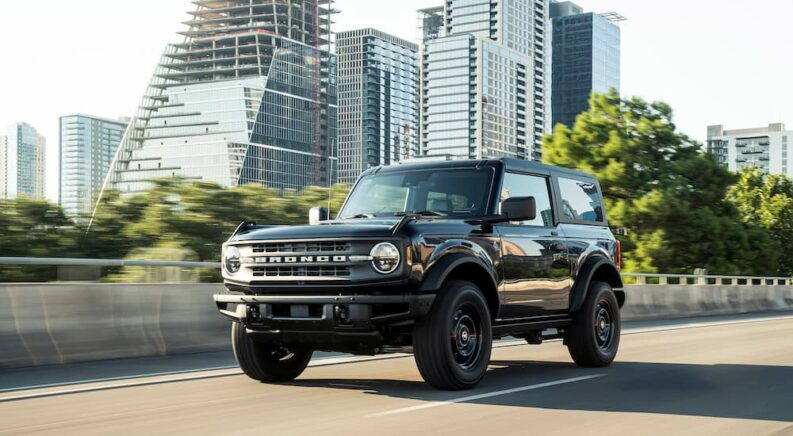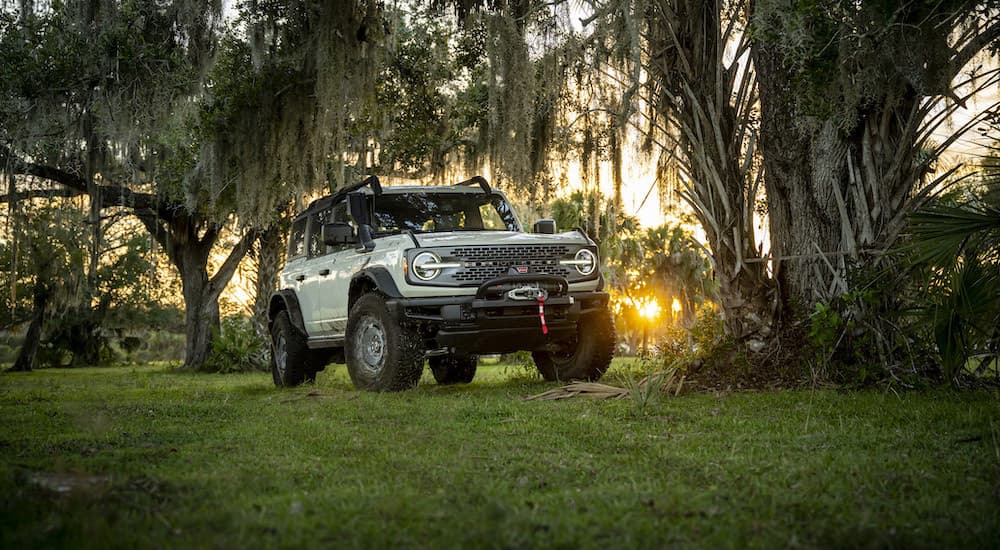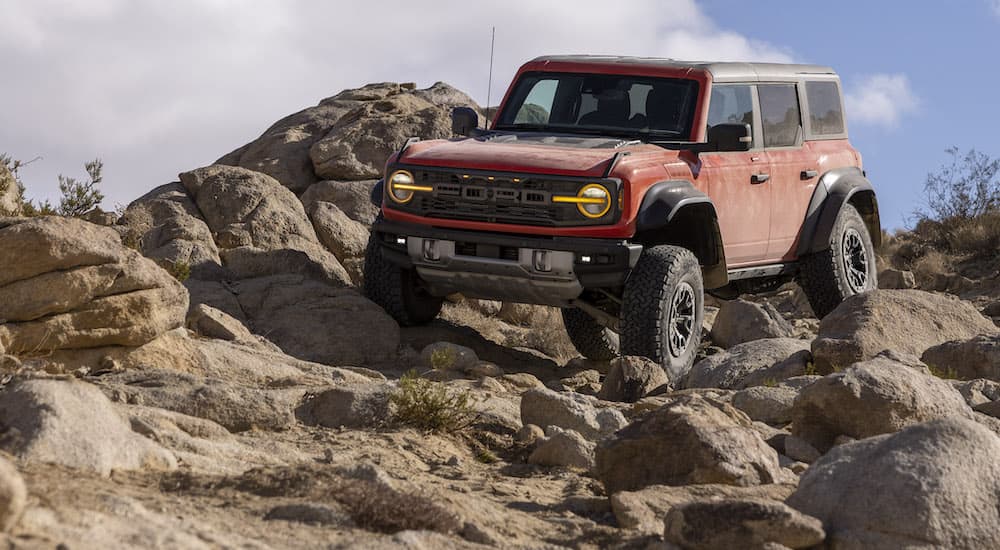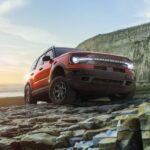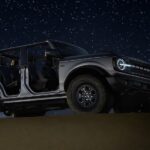There are a few prerequisites for any vehicle that’s looking to try its luck on challenging off-road terrain. A little extra ground clearance is essential, as are specialized off-road tires that maximize traction on uneven or loose surfaces, but if there was just one area to focus on, it would have to be the suspension. From axles, springs, and dampers to sway bars, bump stops, and steering systems, a good suspension is essential when it comes to achieving off-road success, a fact that Ford has taken to heart when designing the Ford Bronco. Ford’s off-road SUV has won plenty of accolades since being reintroduced to the market back in 2021, and while many have focused on the model’s iconic throwback styling, it’s the Bronco’s off-road resume that really sets it apart from the crowd.
Those seeking a used Ford Bronco for sale have probably noticed one term comes up time and time again when researching the SUV’s off-road arsenal: HOSS. Short for High-Performance Off-Road Stability Suspension, the HOSS system plays a crucial role in ensuring consistent off-road performance. HOSS comes standard on all Bronco models, but Ford offers four HOSS variants ranging from the base HOSS 1.0 package to the top-tier HOSS 4.0 that’s exclusive to the trophy-truck-inspired Raptor trim. So what are the differences between each HOSS variant, and which one is the right choice for your unique driving needs? Read on as we take a closer look at Ford’s exclusive suspension technology and see how the Bronco is quickly earning a reputation amongst the off-road set.
HOSS 1.0]
Trims: Base, Big Bend, Outer Banks, and Black Diamond
While it might be the Bronco’s base suspension offering, there’s certainly nothing basic about the HOSS 1.0 package. It all starts with the Bronco’s independent front suspension (IFS) front axle, forged alloy A-arms, and long-travel coil-over springs. An IFS is crucial for responsive handling, allowing each side of the vehicle to move independently of the other for maximum traction and control when you’re out on the trail. Ford has found the perfect balance between strength and weight when designing the Bronco’s front suspension, which is lighter than most of its competitors while keeping each tire firmly on the ground to ensure consistent performance.
The Bronco’s rear suspension is built around a solid axle with variable-rate coilover springs. Unlike constant-rate springs, these springs provide a comfortable ride under both on and off-road conditions by offering changing spring rates as they are compressed. This approach not only reduces pitch and roll but also goes a long way toward smoothing out bumps in the road and preventing the type of bottoming out that can result in costly damage. The front and rear coil springs are supplemented by a set of specially tuned Hitachi twin-tube telescopic dampers, which reduce bounce and improve overall control.
Rounding out the HOSS 1.0 system is the Bronco’s rack-and-pinion steering setup. This type of steering offers many advantages over the recirculating ball approach used in the Wrangler, especially when you’re venturing off-road. In addition to improving steering feel, the rack-and-pinion system can be subtly tuned to provide varying levels of resistance and damping depending on the selected drive mode. In the Raptor’s Sport mode, for instance, the steering becomes tighter for improved control at higher speeds, while its Comfort mode provides a softer, more forgiving steering response.
HOSS 2.0
Trims: Badlands, Everglades, Wildtrak, and Sasquatch Package
Those opting for the Badlands, Everglades, and Wildtrak trims, or any Bronco equipped with the Sasquatch Package, will see HOSS 1.0 replaced with a host of trail-worthy upgrades courtesy of HOSS 2.0. Ford has upsized the front axle for greater durability, but it’s the wider track and upgraded dampers that really make all the difference. The base twin-tube dampers have been replaced by the industry’s go-to name for off-road performance as Bilstein finds its way into the Bronco.
Designed with three-zone damping, these position-sensitive monotube dampers should give drivers the confidence to tackle daunting off-road obstacles without having to worry about bottoming out. The shocks are designed with external piggyback bypass reservoirs that increase oil capacity as a means of preventing the dreaded shock fade, but that’s just one part of Bilstein’s double-barreled approach to improving handling and performance. The dampers also come packed with End Stop Control Valves (ESCV) that increase resistance the closer the shocks get to the bottom of their travel.
The HOSS 2.0 steering system all depends on which model you choose. Trims with 33-inch tires will be equipped with the same rack-and-pinion design found on the HOSS 1.0, but springing for the Sasquatch Package adds 35-inch tires and the heavy-duty steering system needed to keep them in check. Those two inches can come in handy in off-road scenarios, so if you see yourself spending a lot of your time away from paved surfaces, it’s a worthwhile upgrade to consider. The HOSS 2.0 system also offers a front stabilizer bar disconnect that improves the SUV’s articulation. While many stabilizer bars require you to come to a stop on a flat surface to disconnect or reconnect, the HOSS 2.0 option can perform the same trick when you’re in the middle of surmounting an off-road obstacle.
HOSS 3.0
Trim: Wildtrak and Badlands
If it’s not clear from the trim’s standard Baja mode setting, the Wildtrak is an SUV that’s designed for some high-speed off-road fun. The Wildtrak’s 330 hp twin-turbo 2.7-liter V6 provides the sort of power that wouldn’t be out of place in an off-road desert race like the Baja 1000, but when an SUV can sprint from zero to 60 mph in 6.2 seconds, it’s important that the suspension is able to keep pace. Ford has outfitted the Wildtrak accordingly, thanks to the HOSS 3.0, which was made standard in 2023, and was added to the Badlands in 2024.
This system adds five-zone rate-sensitive 2.5-inch FOX Racing internal bypass shocks, a severe-duty steering rack, upgraded tie rods, and a rear stabilizer bar on both the two-door and four-door models. The trim’s FOX Racing internal bypass shocks are the clear highlight, providing premium off-road performance while seamlessly transitioning to paved surfaces for maximum comfort. These are almost the same shocks found on the rarefied Bronco Raptor and F-150 Raptor, though they’re smaller and lack the active monitoring and push-button adjustability found on the two Raptor models. Those are certainly two notable exclusions, but when you consider the fact that you can find a used Wildtrak for considerably less than a Bronco Raptor, it’s a trade-off that most drivers will be happy to make.
The nitrogen-charged FOX shocks come complete with frame-mounted external piggyback reservoirs on both the front and rear and can even be rebuilt should they sustain a little too much wear and tear over the course of your travels. That would certainly take some doing, given the shock’s improved thermal capacity and fade avoidance, but it’ll provide valuable peace of mind for those looking to get a taste of the trophy truck lifestyle. Ford rounds out the HOSS 3.0 with a severe-duty steering rack with a high-torque motor, Sasquatch close-ratio steering gear, reinforced inner and outer tie rods with improved articulation and deflection ball joints, and an upgraded steering gear casing borrowed from the Bronco Raptor. This package should go a long way towards improving steering in off-road environs and is well worth the investment for any serious off-roader.
HOSS 4.0
Trim: Bronco Raptor
Finally, there’s Ford’s no-holds-barred off-road beast––the Bronco Raptor. Packed with every conceivable off-road upgrade, the SUV’s HOSS 4.0 represents the pinnacle of performance for those who enjoy exploring the road less traveled. A 235 mm solid rear axle is a welcomed upgrade over the 220 mm design found on the other HOSS packages, but it still somehow manages to be the least compelling addition of the bunch.
The HOSS 4.0’s FOX 3.1-inch internal bypass semi-active shocks deserve the top billing, especially when you consider that they’re the same shocks soaking up the bumps and dips for the modern-day supertruck that is the F-150 Raptor. Designed with FOX Live Valve technology, these shocks use real-time suspension telemetry to constantly adjust the compression and rebound valving in reaction to the changing terrain. By considering various factors like speed, yaw, roll, suspension position, acceleration, and braking, the Live Valve system takes much of the guesswork out of off-road driving and provides infinite-zone damping that gives drivers the ability to put the Bronco through its paces under any conditions they might encounter.
As far as the rest of the suspension is concerned, the HOSS 4.0-powered Bronco Raptor hardly resembles the rest of the trims. Ford has not only outfitted the Bronco Raptor with its own one-of-a-kind suspension components, but it’s also given the SUV its own proprietary suspension geometry designed for high-intensity off-road use. Throw in bespoke frame rails, bump stops, axles, and even an entirely new driveline, and it’s easy to see why the model commands its lofty price. The HOSS 4.0 package gives the Bronco Raptor the sort of durability that should make for years of rugged off-road fun while allowing the SUV to retain its on-road manners regardless of how many dunes you’ve jumped or rocks you’ve climbed.
Like a HOSS
The Ford Bronco has always had the makings of an off-road contender, but the addition of the High-Performance Off-Road Stability Suspension solidifies that reputation while giving drivers one of the most well-equipped SUVs on the market. Off-road models are all the rage these days, but few can match the sheer performance and customization potential of the Ford Bronco. While it’s always nice to be able to tailor your ride to your own preferences, the sheer number of HOSS systems can be a little overwhelming. While each level has its pros and cons, we think that the HOSS 2.0 might just be the unsung hero of the current lineup. While it lacks some of the heavy-duty equipment found on the HOSS 3.0 and HOSS 4.0, it provides great value for the money with a well-rounded suite of off-road goodies. No matter which used Bronco you choose, the HOSS system is here to power drivers to off-road glory.

